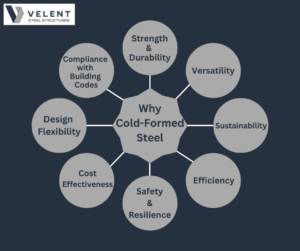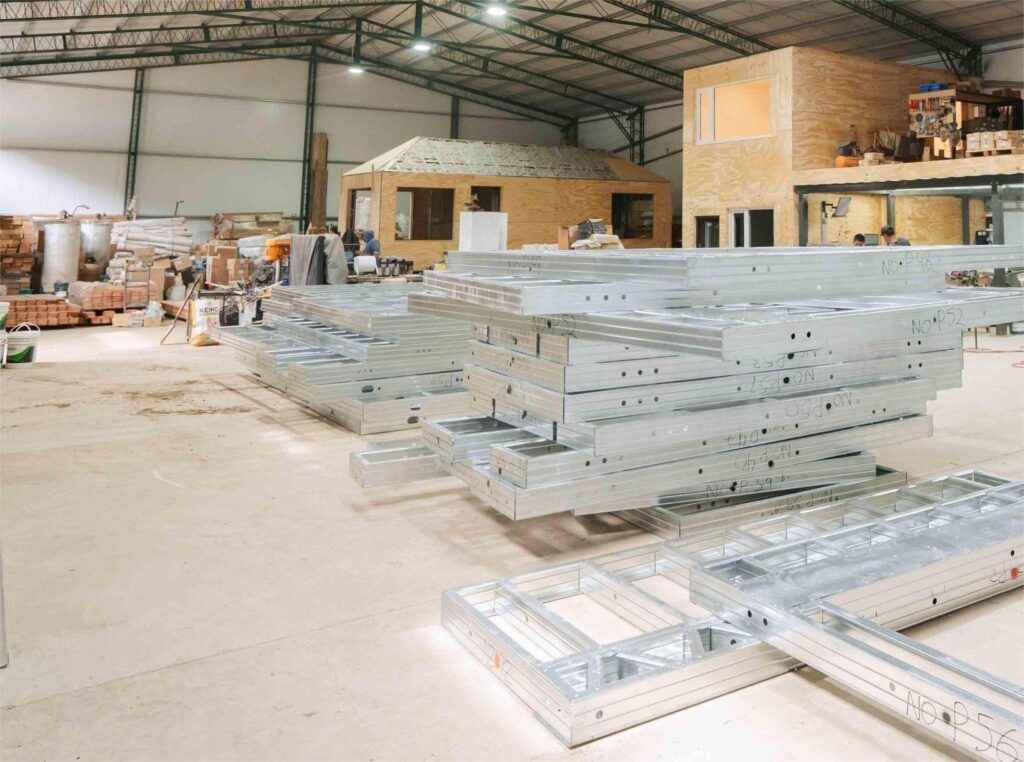Innovation and efficiency are at the heart of each project in the ever-evolving construction industry. Cold-Formed Steel is one of the most revolutionary materials driving this development (CFS). Its versatility, sustainability, and cost-effectiveness are reshaping the design and construction of buildings, from mid-rise commercial structures to modular housing. From mid-rise commercial structures to modular housing, CFS is not just the go-to material but a game-changer. This blog explores why cold-formed steel is the future of construction and why industry leaders are increasingly turning to this revolutionary solution.
What is Cold-Formed Steel?
Cold-formed steel is manufactured by rolling or pressing steel into thin sheets at room temperature. This process creates lightweight yet incredibly strong steel components, which are ideal for structural and non-structural applications. Unlike traditional hot-rolled steel, CFS achieves its strength through its shape and design, not just its thickness or weight.
The benefits of CFS extend far beyond its physical properties, making it an invaluable asset in modern construction.
Why Cold-Formed Steel is Revolutionizing Construction

1. Enhanced Strength and Durability
CFS is light yet surprisingly strong. The strength-to-weight ratio is quite high so that it can carry loads without unnecessarily weighing a structure. This makes it apt for anything from soaring high-rise buildings to versatile modular construction. CFS also has resistance to mold, termites, and corrosion; this makes it long-lasting, with lower maintenance costs over time.
2. Unmatched Versatility
One of the prominent features of CFS is its versatility in different construction applications. Its lightness, durability, and friendliness to design make it one of the top picks for a wide range of projects.
- Mid-rise buildings: CFS enables mid-rise structures to go even higher while not impacting the strength or efficiency of buildings. Its load-carrying capacity and compatibility with many materials make it rather practical as well as relatively economical.
- Residential Homes: CFS framing offers unparalleled flexibility in design, accommodating everything from traditional layouts to contemporary architectural styles. Additionally, its resistance to pests, mold, and fire ensures lasting safety and durability in family homes.
- Industrial Facilities: CFS delivers precision and reliability for industrial projects where specific structural requirements are often critical. Its adaptability supports large open spans, mezzanine systems, and custom configurations, ideal for warehouses, factories, and logistical centers.
- Modular Construction: Modular construction is one of the main applications of cold-formed steel, where parts are manufactured off-site and assembled on-site. The method reduces the time and cost of construction while providing consistency in quality, which explains its popularity for quick-build projects like temporary housing, healthcare facilities, and classrooms.
CFS’s ability to fit diverse construction needs makes it a preferred choice for architects and engineers worldwide.
3. Sustainability and Environmental Impact
Since the construction industry is shifting toward sustainability, CFS has been established as an eco-friendly material that offers many benefits:
- Recyclability: Steel is 100% recyclable and can be reused infinitely without any loss of quality or strength. It reduces waste, minimizes virgin materials, and conserves natural resources. For instance, the use of recycled steel makes most CFS products environment-friendly.
- Energy Efficiency: CFS’s lightweight nature simplifies construction and significantly reduces transportation emissions. Fewer trucks and less fuel are required to transport materials to construction sites, contributing to lower carbon dioxide emissions across the supply chain.
- Long Lifespan: Steel structures are remarkably durable and resist the ravages of pests, mold, and elements. This quality makes them less prone to replacement and repair, which consumes a lot of resources and produces waste during the building’s lifetime.
- Lower Construction Waste: CFS framing can be precision-engineered off-site, thus ensuring exact material usage and minimizing construction waste. Additionally, leftover steel scraps from manufacturing are recyclable, thus again contributing to waste minimization.
- LEED and Green Certifications: CFS is easily aligned with green building standards like LEED and BREEAM. So it is easy to obtain a variety of sustainability certifications for the different projects. Inherent recyclability, energy efficiency, and the capacity to adapt to eco-friendly designs will strengthen the implementation of these prestigious frameworks.
Incorporation of CFS in construction projects not only provides strong and efficient buildings but also meaningfully contributes to global efforts to reduce environmental impacts and combat climate change. It is through the selection of CFS that builders and developers can meet today’s sustainability demands while building for a greener tomorrow.
4. Improved Construction Efficiency
Time is money in construction, and CFS delivers on both fronts. It enables off-site fabrication, where components are precision-engineered in controlled environments. This approach:
- Reduces on-site labor requirements: By minimizing manual assembly at the site, teams can focus on installation rather than fabrication, optimizing manpower allocation.
- Minimizes waste: Precision engineering ensures exact material usage, cutting waste by up to 30% compared to traditional methods.
- Speeds up construction timelines: Pre-assembled components mean projects move faster from planning to completion, enabling quicker market readiness.
For example, CFS can cut construction time by up to 30% compared to traditional materials. This efficiency is a significant advantage in large-scale projects.
5. Safety and Resilience
In areas prone to natural catastrophes, CFS comes out as the most sturdy and dependable alternative. It can withstand seismic activity, fierce winds, and fire and ensure both the building and its inhabitants are secured. For example, in seismic zones, the lightweight character of CFS reduces inertial forces, which decreases the probability of causing structural damage.
6. Cost-Effectiveness
While the cost of CFS may be considerably more expensive than traditional materials to begin with, the payoff is found in the long-run benefits. It saves money in the life cycle of a building for lower labor costs, faster construction schedules, and low maintenance.
7. Design Flexibility
CFS allows architects and designers to explore innovative ideas without compromising structural integrity. Its lightweight nature enables unique shapes and designs that are otherwise challenging with conventional materials.
8. Compliance with Modern Building Codes
CFS meets or exceeds modern building codes, including energy efficiency and safety standards. Its inherent properties simplify compliance, providing peace of mind for developers and contractors.
Applications of Cold-Formed Steel
Residential Construction
CFS is a popular choice in residential projects due to its adaptability and sustainability. Homeowners get to enjoy long-lasting, energy-efficient, and low-maintenance structures with CFS.
Commercial Construction
In mid-rise office buildings and retail spaces, CFS provides cost-effective and scalable solutions. It’s particularly valuable in projects with tight schedules and high-performance demands.
Industrial Facilities
Industrial facilities require materials that can withstand heavy usage and environmental stressors. CFS delivers unmatched durability and customization options, making it ideal for warehouses, factories, and storage units.
Modular Construction
Modular construction is revolutionizing how buildings are assembled, and CFS is at its core. Prefabricated CFS components are transported to the site for quick assembly, significantly reducing construction time.
Future Trends: How CFS is Shaping the Industry
1. Digital Integration
The rise of Building Information Modeling (BIM) has aligned seamlessly with the use of CFS. Digital tools enable precise design and efficient production, ensuring components fit perfectly during assembly.
2. Focus on Sustainability
As sustainability becomes a global priority, the demand for recyclable and eco-friendly materials like CFS will continue to grow. This aligns with green building certifications such as LEED and BREEAM.
3. Expansion in Modular Construction
With the modular construction market projected to grow significantly, CFS’s role will only expand. Its compatibility with prefabrication and off-site assembly makes it a cornerstone of this construction trend.
4. Increased Use in Disaster-Resilient Design
The need for disaster-resistant structures will drive the adoption of CFS in regions prone to earthquakes, hurricanes, and wildfires. Its performance under such conditions is unmatched by traditional materials.
Partner with Velent Steel Structures
At Velent Steel Structures, we’re at the cutting edge of the CFS revolution. From concept to completion, our team offers comprehensive solutions tailored to your needs. Whether it’s a residential project, a mid-rise commercial building, or an industrial facility, we help you unlock the full potential of cold-formed steel.
Ready to Build the Future?
The construction industry is embracing innovation, and cold-formed steel is leading the way. Its benefits—from efficiency and sustainability to resilience and versatility—make it the material of choice for modern builders.
Let’s collaborate to turn your vision into reality. Contact us today or visit velent.com to learn more about our CFS solutions. Together, we’ll build a stronger, smarter, and more sustainable future.


